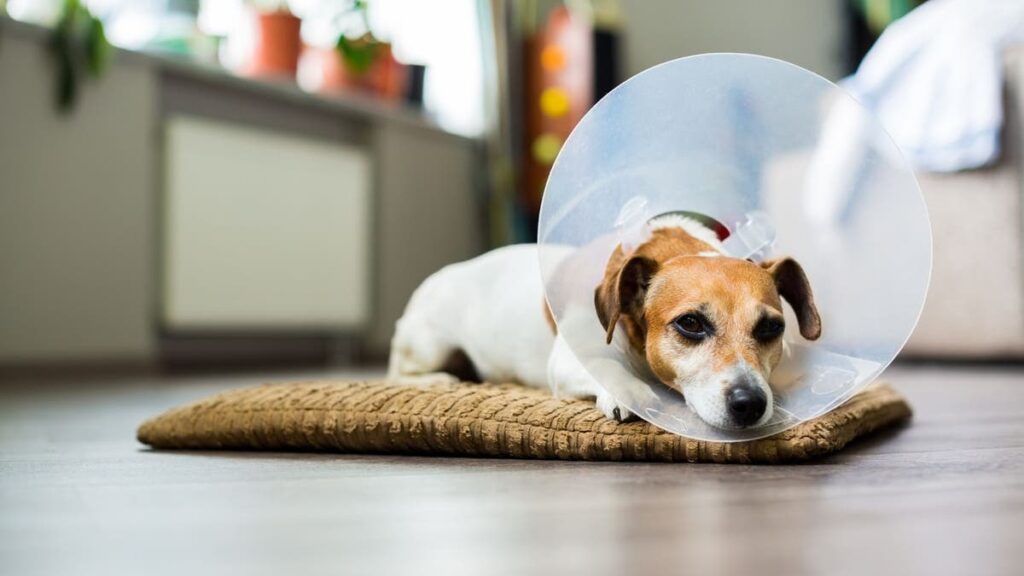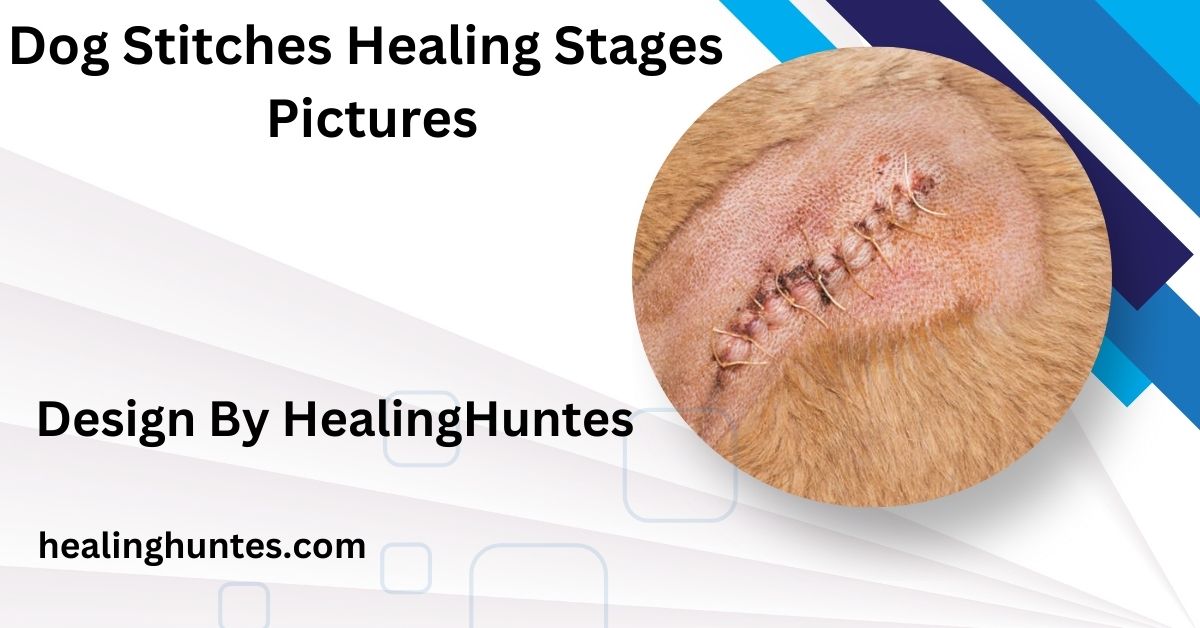Dog Stitches Healing Stages Pictures – Full Recovery Dog Stitches!
Dog stitches heal in stages: post-surgery, early healing, mid-healing, late healing, and full recovery. Proper care, like preventing licking and limiting activity, ensures smooth healing.
In this article, we’ll explore the dog stitches healing stages, provide helpful pictures, and give tips for optimal care during each phase.
Dog Stitches Healing Stages: A Complete Guide with Pictures

When your dog undergoes surgery or sustains a wound requiring stitches, it’s important to understand the healing process to ensure a smooth recovery. Just like humans, dogs go through various stages of healing after stitches, and monitoring the progress is crucial for their well-being.
What Are Dog Stitches?
Dog stitches, also known as sutures, are used to close wounds or surgical incisions. Whether the stitches are needed due to surgery, injury, or another medical condition, their primary purpose is to help the tissue heal by holding it together. There are two main types of stitches used in dogs:
- External Stitches: These are placed on the skin and are visible on the surface.
- Internal Stitches: These are used to close deeper tissue and may not be visible on the surface.
Regardless of the type of stitches, the healing process involves several key stages that need to be carefully monitored.
Dog Stitches Healing Stages: What to Expect
Immediate Post-Surgery: (Days 1-2)
What to Expect:
After your dog’s surgery, you may notice some swelling, redness, and slight bleeding around the stitches. The area might appear a bit puffy, and you may see a small amount of clear or blood-tinged fluid leaking from the site.
Healing Process:
In the initial stages, the body begins forming blood clots to stop bleeding, and the stitches are helping to hold the tissue together. The wound may still be very sensitive, and your dog might show signs of discomfort.
Care Tips:
- Keep the wound clean and dry.
- Prevent your dog from licking or biting the stitches, as this can cause infection.
- Follow your vet’s instructions on medication and care.
Also Read: How Long Does A Tongue Piercing Take To Heal – A Complete Guide!
Early Healing Phase: (Week 1-2)
What to Expect:
Within the first couple of weeks, the wound site should start to look less red and swollen. The stitches will be in place, and you may see some scabbing forming over the wound. The area might still feel warm to the touch.
Healing Process:
The tissues beneath the surface start to knit together as the body begins to repair the wound. You may notice your dog becoming more active, but it’s still important to restrict their movement to prevent strain on the stitches.
Care Tips:
- Continue monitoring for signs of infection, such as excessive redness or pus.
- Keep your dog’s activity level low to avoid disturbing the stitches.
- Consider using an Elizabethan collar (cone) to prevent licking.
Mid-Healing Phase: (Week 2-4)

What to Expect:
By the second to fourth week, the swelling should have subsided, and the wound will begin to show significant signs of healing. You may see some mild scabbing, and the stitches may start to look looser or less tight.
Healing Process:
The tissue is continuing to heal, and the body is creating new skin to seal the wound. Depending on the type of stitches used, your vet may recommend removing the stitches at this stage if they are not dissolvable.
Care Tips:
- If the stitches are external and not dissolvable, schedule a follow-up appointment to remove them.
- Keep your dog’s wound clean, dry, and free of debris.
- Avoid any rough play or activity that could strain the stitches.
Late Healing Phase: (Week 4-8)
What to Expect:
At this point, the wound should be nearly healed, and the stitches will likely be removed or have dissolved. The area may still show some mild signs of scarring, and the skin will look pinkish or lighter than the surrounding fur.
Healing Process:
The wound is now fully closed, and the tissue continues to strengthen and mature. The scar tissue begins to form, and the skin becomes more elastic and resilient.
Care Tips:
- You can start gradually allowing more movement, but avoid high-impact activities for a few more weeks.
- Monitor for any abnormal swelling, redness, or signs of infection.
- Applying a soothing ointment (prescribed by the vet) may help with healing and scar reduction.
Full Recovery: (Months 2-3)
What to Expect:
After two to three months, your dog’s wound should be fully healed, and any remaining scars will begin to fade. The fur may start to grow back over the healed area, although the new hair may appear slightly different in texture or color.
Healing Process:
At this point, the tissue is fully repaired, but some scarring may remain. The skin will feel firm and may continue to mature over time.
Care Tips:
- Continue monitoring the site for any signs of abnormal changes.
- If the scar remains raised or hard, ask your vet for advice on scar management.
- Gradually return to normal activity, keeping an eye on the healing progress.
Also Read: How Long Can A Stress Fracture Take To Heal – An In-Depth Overview!
How to Care for Dog Stitches?
Proper aftercare is essential to ensuring that your dog’s stitches heal as quickly and smoothly as possible. Here are some key care tips to keep in mind during the healing stages:
- Prevent Licking or Biting: Dogs often try to lick or chew at stitches, which can introduce bacteria and delay healing. Using an Elizabethan collar (cone) or a protective sleeve is important.
- Limit Physical Activity: After surgery, your dog should avoid excessive movement, running, or jumping to prevent putting strain on the stitches.
- Regular Check-ups: Schedule follow-up visits with your veterinarian to monitor your dog’s healing progress and get stitches removed, if necessary.
- Clean the Area: Gently clean the wound area as directed by your vet, using a mild antiseptic solution to keep the site free of infection.
- Watch for Signs of Infection: If you notice excessive redness, swelling, discharge, or a foul odor around the stitches, contact your vet immediately.
Factors That Affect Healing:
Several factors can influence how quickly and successfully your dog’s stitches heal:
Dog’s Age and Health: Younger, healthier dogs generally heal faster than older or ill dogs.
Size and Location of the Wound: Larger or more complex wounds may take longer to heal.
Type of Stitch Used: Absorbable stitches usually take longer to dissolve, while non-absorbable ones may need to be removed.
Care and Attention: Proper wound care and keeping the area clean are critical to preventing complications.
FAQ’s
1. How long does it take for dog stitches to heal?
Dog stitches typically heal in 2-3 months, but full recovery, including scar fading, can take up to 6 months.
2. Can I remove the stitches myself?
No, always follow your vet’s instructions. If stitches are non-absorbable, they need to be removed by a professional.
3. What signs of infection should I look for?
Look for excessive redness, swelling, pus, or a foul odor around the stitches. Contact your vet if you notice these symptoms.
4. How can I prevent my dog from licking the stitches?
Use an Elizabethan collar (cone) or a protective sleeve to prevent your dog from licking or chewing at the stitches.
5. What should I do if my dog seems uncomfortable after surgery?
Keep the area clean, limit activity, and follow your vet’s pain management instructions. If discomfort persists, contact your vet for advice.
Conclusion
Understanding the dog stitches healing stages can help you better manage your dog’s recovery process and ensure that they heal properly. By following your vet’s aftercare instructions, monitoring the wound closely, and limiting physical activity, you can help your dog return to normal life as quickly as possible. If you have any concerns about the healing process, don’t hesitate to consult with your veterinarian for advice and further guidance.






